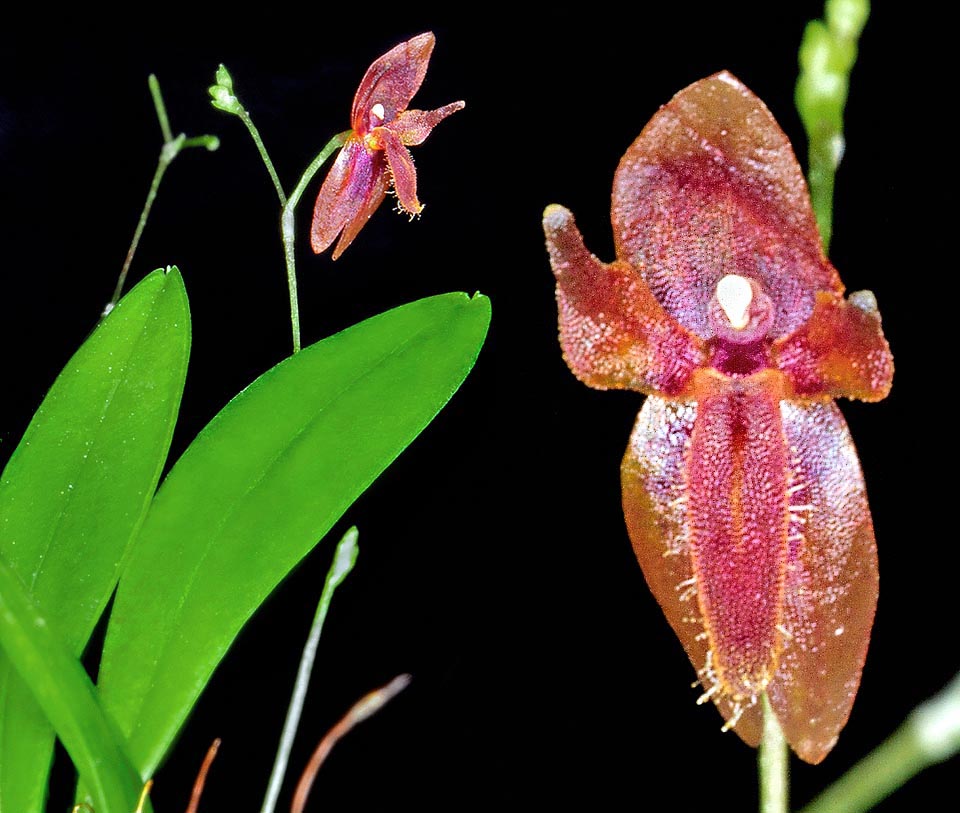Family : Orchidaceae

Text © Pietro Puccio

English translation by Mario Beltramini
The species is native to Colombia, Ecuador and Panama where it grows on the trees of the humid forests between 700 and 1400 m of altitude.
The name of the genus is the combination of the Greek adjective “πλατύς” (platys) = large and of the substantive “στήλη” (stéle) = column, with reference to the dilated above column; the specific name is the Latin adjective “aureus, a, um” = golden, like gold.
The Platystele aurea Garay (1973) is an epiphyte species forming dense tufts with thin stems, 0,3-1 cm long, covered by 1 to 3 tubular sheaths, bearing at the apex a single leaf obovate-elliptic with acute to obtuse apex and thinned base, coriaceous, of intense green colour, 1,5-4,5 cm long and 0,4-0,7 cm broad. Erect racemose inflorescence, up to about 5 cm long, with zigzagging filiform rachis with numerous orange yellow to red flowers, of about 5 mm of diameter, that open singly in succession on a 3-4 mm long pedicel and ovary. Oblong-ovate dorsal sepal with obtuse to acute apex, 3 mm long and 1,5 mm broad, lateral elliptic sepals, 3 mm long and 1 mm broad, united at the base per about half of their length, ovate-lanceolate petals with acute apex of red colour, about 2 mm long and 1 mm broad, purple red linguiform labellum, ciliate, about 3 mm long and 1,5 mm broad, and 0,5 mm long column.
It reproduces by seed, in vitro, but usually recourse is done to the division, as it quickly tillers, with section provided of at least 3-4 stems.

The Platystele aurea is a cespitose epiphyte of Colombia, Ecuador and Panama humid forests. 5 mm flowers on a zigzagging filiform tachis. Easy to cultivate in terraria © Giuseppe Mazza
Mini orchid of easy cultivation with an almost continuous blooming, requires a partially shaded position, intermediate temperatures, high humidity, 70-80 %, and continuous slight movement of air. Ideal for terraria and mini terraria where it is possible to adjust properly all environmental parametres.
It can be mounted on trunks, pieces of bark or rafts of various material covered by a layer of sphagnum to keep the humidity at the roots, or cultivated in small pots with draining compost that can be formed by finely sliced bark fragments and charcoal with addition of sphagnum. The watering must be regular, as it does not have a precise resting period, in way to maintain the substratum permanently humid, but without stagnations that may cause rottenness, utilizing rainwater, de-mineralized or by reverse osmosis. Monthly fertilizations with a product specific for orchids at ¼ of the dosage indicated on the package.
The species is inscribed in the appendix II of the Cites (species whose trade is internationally ruled).
Synonyms: Pleurothallis rubella Luer (1977); Rubellia rubella (Luer) Luer (2004); Rubellia aurea (Garay) Baumbach (2011).
